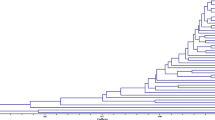Abstract
RAPD markers were used to analyse the genetic variability among a cole crop cultivar collection from France and to identify possible duplicate accessions for facilitating the germplasm multiplication. We surveyed 24 cauliflower, 24 cabbage and 48 kale populations using 62, 100 and 89 RAPD markers respectively on 40 seed bulk samples per accession. Genetic distances were calculated on the basis of these markers. Using the phylogenetic package PAUP we compared the genetic clusters obtained for the RAPD markers with the groups based on morphologic and agronomic data. For cauliflowers and cabbages a drastic selection by growers led to an extensive differentiation of morphologic and precocity traits related to geographic origin, which matches the grouping based on RAPD markers. Furthermore, RAPDs detected in some cases misclassification of accessions in the collection. Kales formed an homogeneous group probably due to extensive genetic exchanges leading to a continuous diversity. For the other crops, different horticultural types were separated in several subgroups by the RAPD markers suggesting different genetic origins. RAPD markers provide a rapid and informative approach to analyze the genetic variability in a collection. It can be applied to autogamous (spring cauliflower) or allogamous (winter cauliflower) crops, even in cases where the intra-population diversity is extensive (cabbages).
Similar content being viewed by others
References
Arus, P. & C.R. Shields, 1983. Cole Crops (Brassica oleracea L.). In: S.D. Tanksley & T.J. Orton (Eds). Isozymes in Plant Genetics and Breeding. Elsevier Science Publishers, Amsterdam, pp 339–348.
Bettencourt, E. & J. Konopka, 1990. Directory of Crop Germplasm Collections. 4. Vegetables:Abelmoschus, Allium, Amaranthus, Brassiccaceae,Capsicum, Cucurbitacea,Lycopersicon, Solanum and other vegetables. International Board for Plant Genetic Resources, Rome.
Crips, P., 1982. The use of an evolutionary scheme for cauliflowers in the screening of genetic resources. Euphytica 31: 725–734.
Demeke, T., R.P. Adams & R. Chibbar, 1992. Potential taxonomic use of random amplified polymorphic DNA (RAPD): a case study inBrassica. Theor. Appl. Genet. 85: 190–196.
Dias, J.S., M.B. Lima, K.M. Song, A.A. Monteiro, P.H. Williams & T.C. Osborn, 1992. Molecular taxonomy of Portuguese tronchuda cabbage and kale landraces using nuclear RFLPs. Euphytica 58:221–229.
Du Crehu, G., 1964. La biologie florale du chou-fourrager; ses conséquences pour la sélection. Ann. Amelior. Plant. 14: 5–37.
Du Crehu, G., 1957. Le chou-fourrager. Etude biologique. Problèmes variétaux. Ann. Amelior. Plant. 3: 313–336.
Goodman, M.M., 1990. Genetic and Germ Plasm Stocks Worth Conserving. J. Hered. 81: 11–16.
Hu, J. & C.F. Quiros, 1991. Identification of Broccoli and Cauliflower cultivars with RAPD markers. Plant Cell Rep. 10: 505–511.
Kresovich, S., J.G.K. Williams, J.R. McFerson, E.J. Routman & B.A. Schaal, 1992. Characterization of genetic identities and relationships ofBrassica oleracea L. via a random amplified polymorphic DNA assay. Theor. Appl. Genet. 85: 190–196.
Margalé, E., Y. Hervé, J. Hu & C.F. Quiros, 1994. Characterization by RAPD markers of a local cole crop cultivar collection from France: optimal sample size and number of markers. (Euphytica in press).
Margalé, E., A.M. Chevre, R. Delourme & Y. Hervé, 1994. Description de la diversité génétique chezBrassica olevacea à l'aide de marqueurs isoenzymatiques et moléculaires. Genet. Scl. Evol. 26: 137s-153s.
Pouvreau, A. 1984. Production de semences potageres. In: P. Pesson & J. Louveau (Eds). Pollinisation et productions vegetales. INRA, Paris, pp 471–495.
Prakash, S. & Hinata, 1980. Taxonomy, cytogenetics and origin of crop Brassicas, a review. Opera bot. 55: 1–57.
Song, K., T.C. Osborn & P.H. Williams, 1990.Brassica taxonomy based on nuclear restriction fragment length polymorphisms (RFLPs). 3. Genome relationships inBrassica and related genera and the origin ofB. oleracea andB. rapa (syn.campestris). Theor. Appl. Genet. 79: 497–506.
Thompson, K.F., 1986. Cabbage, Kales, etc. In: N.W. Simmonds (Ed). Evolution oc Crop Plants. Longman Scientific and Technical, Hong Kong, pp 49–52.
Watts, L.E., 1965. Investigations into the breeding system of cauliflowersBrassica oleracea var.botrytis. I. Studies of selfincompatibility. Euphytica, 12: 323–340.
Author information
Authors and Affiliations
Rights and permissions
About this article
Cite this article
Margalé, E., Hervé, Y., Hue, J. et al. Determination of genetic variability by RAPD markers in cauliflower, cabbage and kale local cultivars from France. Genet Resour Crop Evol 42, 281–289 (1995). https://doi.org/10.1007/BF02431263
Received:
Accepted:
Issue Date:
DOI: https://doi.org/10.1007/BF02431263




